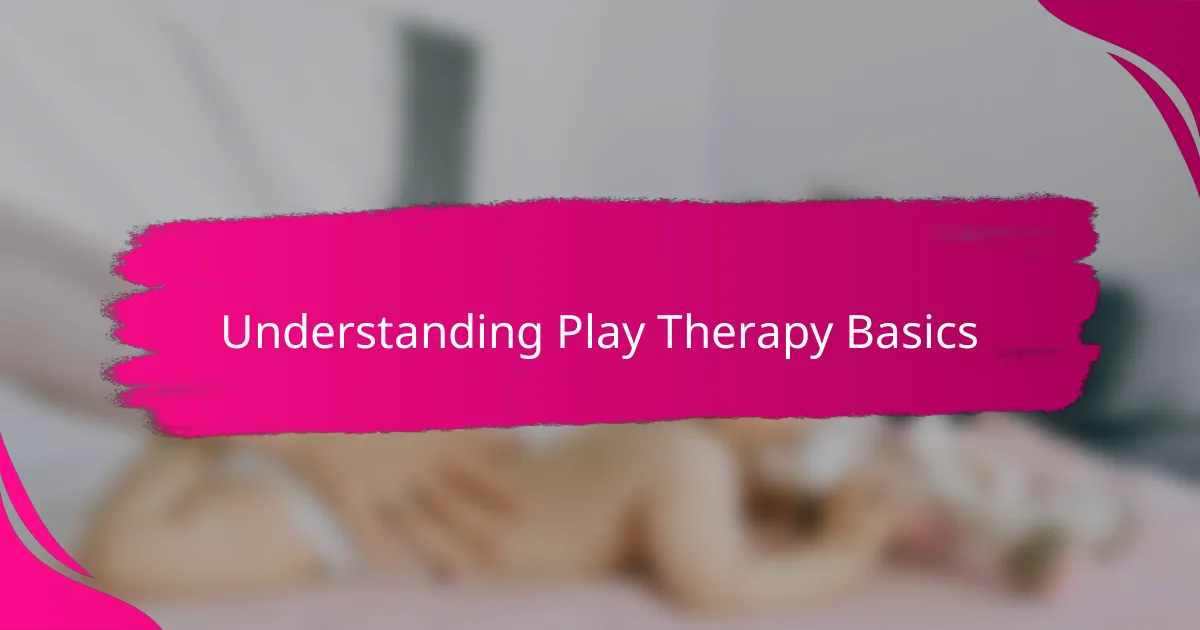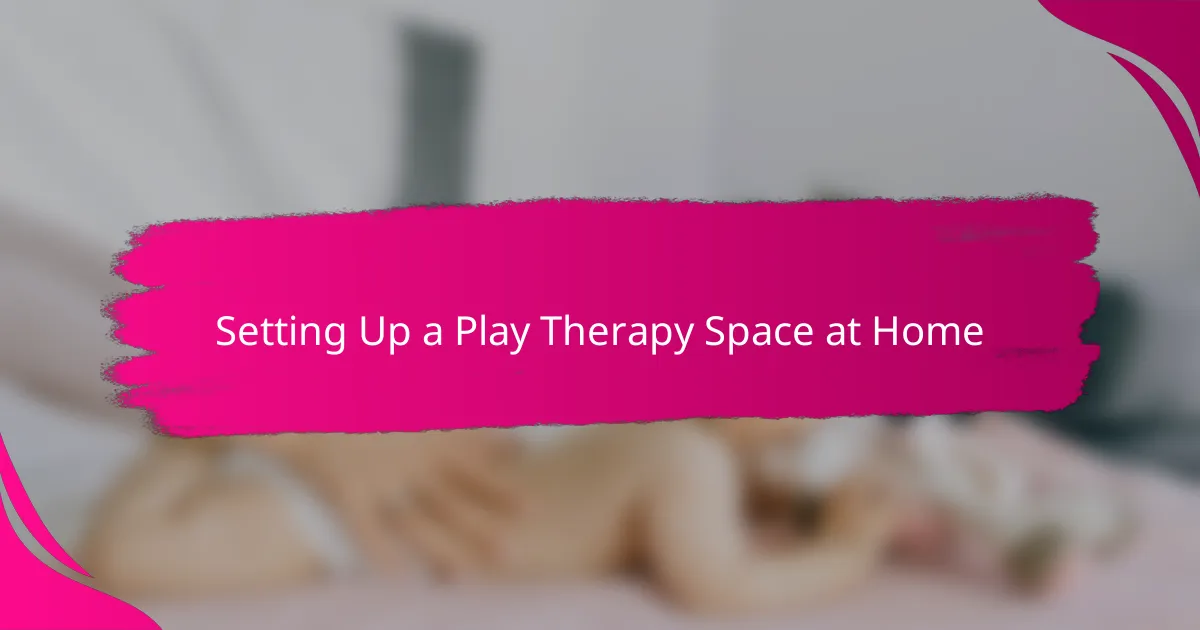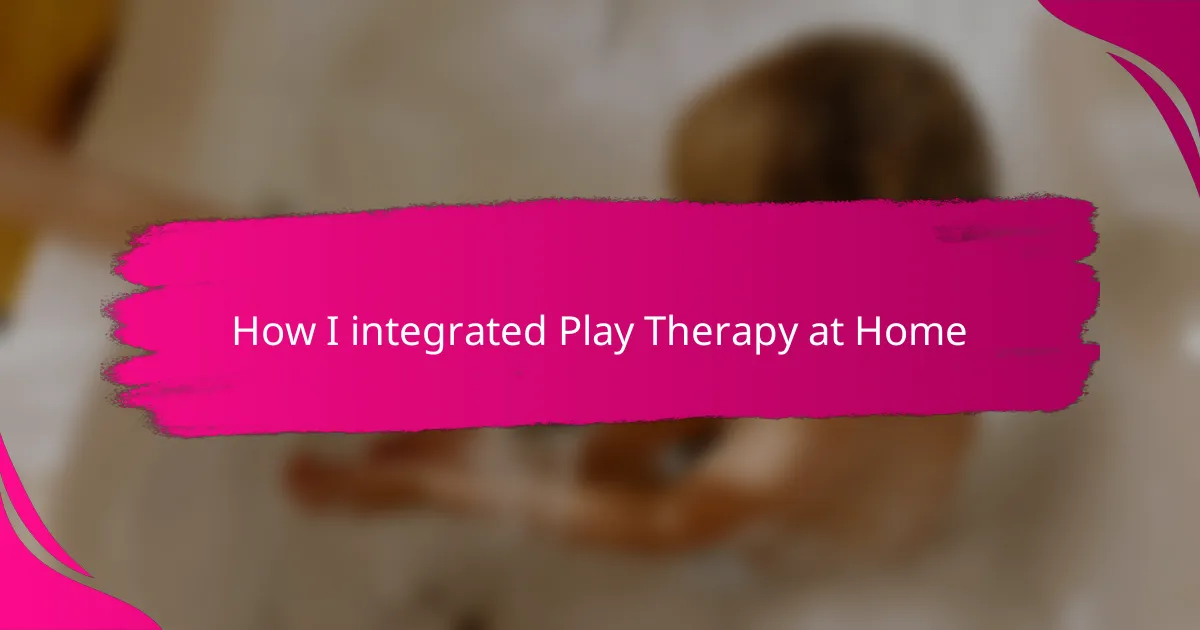Key takeaways
- Play therapy allows children to express emotions and thoughts through play, creating a safe space for exploration and healing.
- It helps develop emotional intelligence, problem-solving skills, and fosters trust, boosting children’s confidence.
- Setting up a comfortable and flexible play therapy space encourages creativity and emotional expression without pressure.
- Integrating play therapy into daily routines can enhance emotional connections, making sharing feelings a natural part of everyday interactions.

Understanding Play Therapy Basics
Play therapy is such a fascinating approach because it lets children express thoughts and feelings that they often can’t put into words. When I first learned about it, I realized how powerful play can be as a language for kids – it’s where their emotions come alive naturally. Have you ever noticed how your child’s favorite games or toys sometimes reveal what’s on their mind?
What I find most meaningful about play therapy is that it creates a safe space for children to explore their inner world without fear or judgment. This is something I’ve seen firsthand; when my own child was going through a tough time, simply watching them immerse in play helped me understand things they hadn’t told me directly. It’s incredible how play becomes a bridge for emotional healing and growth.
I often wonder how many of us overlook the simple magic behind play. It’s not just about fun; it’s a therapeutic tool that helps kids process experiences and build resilience. From my experience, recognizing this has transformed how I connect with my child and other children around me. Wouldn’t it be wonderful if more parents viewed play as more than just entertainment but as a vital part of emotional development?

Benefits of Play Therapy for Children
One of the biggest benefits I noticed with play therapy is how it helps children develop emotional intelligence. Through play, kids learn to identify and manage their feelings, sometimes showing me emotions they hadn’t expressed before. Have you ever seen a child act out a story during play and suddenly realize what they’re really struggling with? That moment of insight was eye-opening for me.
Play therapy also supports problem-solving skills in ways that feel natural to children. I saw this when my child began organizing scenarios with toys to work through conflicts, which gave me hope for their growing ability to handle challenges independently. It’s amazing how something so simple can strengthen such essential life skills.
Finally, play therapy fosters a deep sense of security and trust. When my child felt heard and accepted during our play sessions, I could see a boost in their confidence and willingness to share. This kind of connection is priceless; it shows me that play isn’t just about fun—it’s a vital part of helping children feel safe and understood.

Setting Up a Play Therapy Space at Home
Creating a dedicated play therapy space at home doesn’t have to be complicated. When I set up our corner, I chose a quiet spot with soft lighting and a few cozy cushions to make it inviting. Have you ever noticed how a calm environment can help your child feel more at ease? That little change made a huge difference for us.
I made sure to include a variety of toys and materials that encourage creativity and expression, like puppets, art supplies, and some figurines. Watching my child reach for different items during play helped me understand what kinds of tools sparked their imagination—and, more importantly, their emotions. It’s fascinating how the right setting can unlock so much storytelling.
Most importantly, I kept the space flexible and clutter-free so it never felt like a ‘task’ area. I wanted it to feel natural, like an extension of playtime rather than a therapy session. Don’t you think that when kids feel free and comfortable, they open up in ways we might never expect? That’s exactly what happened in our small, simple corner of home.

Essential Play Therapy Tools and Materials
One of the first things I realized when integrating play therapy at home was the importance of having the right tools. Simple items like art supplies—crayons, paints, and paper—became our go-to materials, allowing my child to freely express feelings that words just couldn’t capture. Have you ever watched a child’s face light up when given a blank sheet and some colors? That moment of pure expression is truly powerful.
I also found that sensory materials, like playdough or textured fabrics, added another layer to our sessions. These tools invite children to explore emotions through touch and movement, which can be incredibly soothing and revealing. From my experience, including familiar toys alongside new materials creates the perfect balance between comfort and discovery.
Finally, I kept a small box of figurines and puppets handy, which became stars in our imaginative stories. These figures often helped my child enact feelings or situations that felt too big to talk about directly. Isn’t it amazing how a tiny character can open the door to deep conversations? For me, these simple but meaningful tools transformed our playtime into genuine healing moments.

Incorporating Play Therapy into Daily Routines
Integrating play therapy into everyday routines felt more natural than I initially expected. I started by weaving short, intentional play sessions right after school or before bedtime, turning these moments into opportunities to connect emotionally. Have you ever noticed how seamlessly play becomes part of your child’s day when it’s gentle and unforced? That’s exactly what happened in our home.
I also realized that play therapy doesn’t need to be a separate “activity” but can flow through daily interactions—like making dinner or picking up toys together. For instance, I’d ask open-ended questions during these tasks, encouraging my child to express feelings through storytelling or imaginative scenarios. This approach made emotional sharing feel less like a chore and more like a natural extension of our time together.
Sometimes, I found that even brief pauses during routine moments sparked meaningful play and communication. When frustration or anxiety crept in, we’d take a few minutes to use a favorite toy or drawing to explore those feelings. Isn’t it powerful how tiny pockets of play within daily life can build emotional bridges? In my experience, consistent, simple integration truly deepened our bond.

Overcoming Common Challenges in Play Therapy
One challenge I faced early on was staying patient when my child resisted playing in the “therapy” space. At first, I worried it meant failure, but I learned that gently following their lead, rather than forcing the play, made all the difference. Have you ever noticed how children open up best when they feel safe and in control? That subtle shift in mindset helped me overcome resistance and find moments of true connection.
Another hurdle was knowing when to step back instead of guiding every play scenario. I used to jump in too quickly to interpret or solve, but play therapy works best when children lead the story. It took practice to resist the urge to fix things and instead simply observe—and honestly, witnessing their creativity unfold without interruption was surprisingly rewarding. Isn’t it fascinating how just being present can encourage children to reveal what’s on their hearts?
Sometimes, balancing play therapy with a busy schedule felt overwhelming. I wondered if small, irregular sessions could still be effective. Through trial, I discovered even brief, spontaneous moments of play infused with genuine attention brought meaningful progress. Doesn’t it reassure you that consistency doesn’t mean long hours, just quality time where your child feels truly heard? That realization eased the pressure and made therapy more sustainable at home.

Measuring Progress and Adjusting Techniques
Measuring progress in play therapy at home often feels less like tracking milestones and more like noticing subtle shifts in your child’s behavior or mood. I found myself paying close attention to how my child expressed emotions during play—was there more openness, less frustration, or new themes emerging in their stories? These small but significant signs became my guideposts for understanding growth.
Adjusting techniques was a natural part of this process. Sometimes, a toy that once sparked meaningful play lost its appeal, so I switched to different materials or approaches to keep the connection alive. Have you ever had to change course because what worked yesterday didn’t work today? I realized flexibility was key, allowing play to meet my child where they were emotionally in that moment.
There were occasions when I wondered if progress was even happening, especially during quiet or reluctant play sessions. But then, I’d recall a recent breakthrough—like my child creatively solving a problem through play or showing empathy in a story—and that kept me encouraged. Isn’t it comforting to remember that healing doesn’t always look dramatic, but often happens in these gentle, almost invisible steps?
